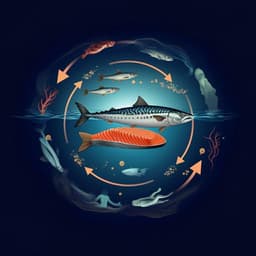
Environmental Studies and Forestry
Nutrient footprint versus EPA + DHA security in land-locked regions—more of local pond farmed, imported marine fish or fish oil capsules?
K. Roy, P. Dvorak, et al.
Discover how land-locked Central Europe can boost its EPA + DHA intake by comparing pond-farmed carp with intensively farmed salmon. This study by Koushik Roy, Petr Dvorak, Zdenka Machova, and Jan Mraz reveals the nutrient footprint and eco-services, suggesting that pond-farmed fish should complement rather than replace salmon and marine fish.
~3 min • Beginner • English
Introduction
The study addresses the challenge that long-chain omega-3 fatty acids (EPA and DHA) intake is insufficient in land-locked Central Europe, where fish consumption is low and terrestrial meat intake is high. Globally, the minimum recommended intake is 250 mg EPA + DHA per person per day, yet current global supply (~420 kt/yr; 149 mg per capita per day) meets only about 60% of minimum demand and 30% of ideal demand. Losses from food waste and underused by-products exacerbate the shortfall, and climate change with declining marine fish stocks could further reduce supply. Blue foods vary widely in EPA + DHA density; farming systems differ in omega-3 out:in conversion efficiency, shaping the environmental footprint of meeting EPA + DHA needs. Central Europe, particularly Czechia, has very low omega-3 index (2.5–3.5%), low fish intake (6–8 kg/capita/yr), and high saturated fat intake from terrestrial meats, contributing to cardiovascular risk. The study’s purpose is to analyze strategies to achieve EPA + DHA security in such land-locked regions with minimal environmental impact, comparing imported marine fish, farmed salmon, local pond-farmed carp, and fish oil capsules. Specifically, using Czechia as a representative case, the study synthesizes: (a) current EPA + DHA security status; (b) GHG emissions of increasing EPA + DHA from different sources; (c) comparative farm nutrient effluents, ecosystem services, and resource-use efficiency between carp and salmon models; and (d) EPA + DHA bioavailability and accumulation in pond carp via non-fishmeal/fish oil pathways.
Literature Review
Methodology
Study setting and consumption patterns: Czechia was used as a representative Central European case. Fish food balances (import/export/production/consumption), surveys of fish consumption, and inventories of fat and EPA + DHA content for commonly eaten fish products (local datasets, prior publications, and unpublished results) were used to estimate per-capita consumption patterns and EPA + DHA supply. Fish oil capsule consumption was estimated from a clinical trial indicating 10% of a subpopulation take omega-3 supplements; extrapolated to 0.2 g fish oil per capita per day. Population data (~10.5 million), per-capita fish consumption (6 kg/yr) and locally produced pond fish consumption (1 kg/yr) were obtained from the Czech Statistical Office.
EPA + DHA content datasets: For pond-farmed common carp (Cyprinus carpio) in Czech and German fishponds (traditional cereal-supplemented semi-intensive ponds), EPA and DHA in fillets were compiled from >100 carp analyzed in the same lab with standard lipid extraction, derivatization, and GC-FID methods across multiple studies (including unpublished). Edible yield up to 60% (45% fillet, 5% separated meat, 10% edible organs/head contents) for market carp (>2 kg) was used to upscale edible fatty acids per kg biomass. For farmed salmon (Norwegian/Scottish origin in RAS/cages), EPA + DHA contents per 100 g fillets came from published datasets; edible yield ~60–67% used for upscaling.
Fish oil capsules and GHG footprint: Typical omega-3 capsules (anchovy/sardine/mackerel/herring oils) in Czechia contain 200–300 mg EPA + DHA (median 250 mg); serving 2 capsules/day (1000–1200 mg oil per capsule). GHG per unit EPA + DHA in captured marine fish were taken from prior LCA (values per 0.5 g EPA + DHA for salmon, herring, mackerel, tuna, cod, pollack). To represent encapsulation, a factor of 2.93 (ratio of refined krill oil capsules to krill meal processing emissions) was applied to in-fish oil LCAs to estimate GHG of encapsulated EPA + DHA. Averages of in-capsule and in-fish values were used for national fish food plate calculations.
GHG footprints of farmed fish and terrestrial references: Carp production GHG was taken from FAO assessments for Eastern Europe/Russia ponds: 1.59 kt CO₂-eq per kt carp. For comparison, traditional wheat feeding in ponds (FCR 2–2.5) suggests 0.74–0.92 kt CO₂-eq per kt carp; the higher (1.59) was used to account for possible pellet/finishing feeds. Farmed salmon GHG used a Norwegian industrial assessment median of 4.57 kt CO₂-eq per kt salmon (range 2.9–6.25). Terrestrial reference categories: white meat (chicken, turkey, duck, eggs) and red meat (beef, veal, pork, lamb, milk), using minimum EU-27 LCA values; EPA + DHA contents were taken from AUSNUT 2011–2013.
Farm nutrient effluents: For carp ponds, combined fecal/non-fecal/uneaten feed N and P loadings used prior CE estimates: traditional semi-intensive ponds minimum values 15.8 kg N and 5.9 kg P per ton carp; for finishing feeding scenarios in ponds, median values 22.9 kg N and 6.7 kg P per ton were used. For Norwegian cage salmon: 50 kg N and 9.3 kg P per ton salmon.
Ecosystem services valuation: Using Czech carp production (~20,000 t/yr over 44,000 ha ponds), an ecosystem/cultural services value of ~2375 € ha⁻¹ and average yield 449.4 kg ha⁻¹, with edible yield 60% and ~70% moisture, the valuation associated with 1 mg edible dry matter (~0.000011 €) was upscaled to consumable EPA + DHA per hectare (296,513–512,605 mg EPA + DHA ha⁻¹) to estimate € value of EPA + DHA "mined" from pond food webs.
Resource Use Efficiency (RUE): Three indices were calculated: EPA + DHA conversion ratio at farm level (EPA DHA-CR), consumable conversion ratio at fork level c(EPA DHA-CR) (applying edible yield coefficient), and EPA DHA-Factor (flesh concentration relative to diet). For carp, whole-body EPA + DHA (1099.7–1901.1 mg kg⁻¹) served as numerator; denominators were either wheat EPA + DHA (≤0.2 mg 100 g⁻¹) multiplied by RFC_drymatter=2 or natural food EPA + DHA (≥60 mg 100 g⁻¹ live biomass; average of cyclops, daphnia, chironomid larvae) multiplied by RFC_wetweight=2.4. Edible yield coefficient 0.60 applied for c(EPA DHA-CR). For salmon, whole-body EPA + DHA (7500–13000 mg kg⁻¹), feed EPA + DHA 1.1% with FCR 1.2, edible yield 0.67.
Bioavailability and accumulation experiments:
- Experiment I (digestibility): Three pond-mimicked diets—HIGH (160.1 mg EPA + DHA 100 g⁻¹), BALANCED (128 mg 100 g⁻¹), LOW (60.1 mg 100 g⁻¹)—created by blending lyophilized natural prey (copepods:cladocerans:chironomids 1:1:1) with wheat; yttrium oxide marker included. Common carp (2+ years, 250–400 g; mixed cohort) held in a 12-tank Guelph-RAS (120 L/tank) at 19–21 °C were fed 2% BW/day for 7 weeks; triplicates per diet. Feces collected and analyzed for fatty acids and yttrium; apparent digestibility coefficients (ADC) for EPA + DHA calculated per standard formulas.
- Experiment II (food-to-flesh FA balances): Fillets from 24 market-size carp (>2.5–3 kg) from traditional wheat/triticale-supplemented ponds (Vodňany; 2020–2022; age 3+, stocking 300–350 kg ha⁻¹, seasonal feeding schedule; sampled pre-purging) were analyzed for FA profiles via established protocols. Six FA ratios were computed on a molar basis in food (median of wheat and natural prey FA ratios; natural prey averaged across copepods, cladocerans, chironomids, mixed zooplankton) and flesh to infer qualitative accumulation/bioconversion patterns toward EPA and DHA. The approach is qualitative and recognizes limitations of ratio-based inference.
Key Findings
- Czech fish food plate EPA + DHA supply: 217.8 mg per capita per day, i.e., 87% of the 250 mg/day minimum recommendation; marine fish dominate intake (61.5% by volume). Highest EPA + DHA sources: canned herring (27.5% of supply), fish oil capsules (23%), smoked mackerel (16.3%), salmon (14.4%).
- Cumulative GHG impact of current aquatic EPA + DHA intake: 84.66 g CO₂-eq. per capita per day; main contributors: marine fish, fish oil capsules, farmed salmonids, and locally farmed carp.
- EPA + DHA density in fillets: salmon 750–1300 mg/100 g (IQR) vs traditional pond carp 101–181 mg/100 g (IQR). Finishing-fed carp can exceed 300 mg/100 g; reported up to ~500–960 mg/100 g under specific finishing regimes.
- GHG per mg EPA + DHA (median comparisons): intensively farmed salmon ~0.8 g CO₂-eq. mg⁻¹ vs traditional pond carp ~1.84 g CO₂-eq. mg⁻¹. With finishing feeding, carp can approach or drop below salmon’s GHG per mg; best-case values: carp 0.53 g and salmon 0.59 g CO₂-eq. mg⁻¹.
- Capsules vs fish: Encapsulated EPA + DHA from marine fish oils can range ~0.59–1.60 g CO₂-eq. mg⁻¹, comparable to or exceeding in-fish EPA + DHA from farmed salmon or finishing-fed carp; in-fish oil (unencapsulated) from some wild species yields still lower GHG per mg (e.g., cod 0.55; pollock 0.20 g CO₂-eq. mg⁻¹ at the oil stage before encapsulation).
- Nutrient effluents per mg EPA + DHA: nitrogen—carp 18.3 mg vs salmon 8.7 mg; phosphorus—carp 6.8 mg vs salmon 1.6 mg. With carp fillet EPA + DHA >300 mg/100 g via finishing feeding, N and P per mg can approach salmon (~10 mg N and ~2.5 mg P per mg EPA + DHA). At ~200 mg/100 g carp, improvements are insufficient.
- Ecosystem services: EPA + DHA obtained via pond carp accrues positive ecosystem service value, estimated >4 € per hectare in EPA + DHA mined (depending on yield assumptions), an attribute absent for intensive salmon systems.
- Resource Use Efficiency (RUE): Carp show high EPA + DHA output-to-input ratios due to natural pond food web contributions. Indicative omega-out:omega-in conversion ratios: pond carp 1–200 (depending on diet base: cereals or natural food) vs intensive salmon ~0.75 (gross) and ~0.4 (consumable). EPA + DHA concentration factor in carp flesh relative to natural prey ~2.5; salmon flesh mirrors feed content (factor ~0.9–1.0).
- Bioavailability and accumulation: EPA + DHA apparent digestibility from pond-mimicked diets was high and consistent (90–91%). FA ratio analyses suggest accumulation/bio-conversion toward EPA, DPA, and DHA in carp flesh (upward shifts in EPA:C20:3n-3; DPA:EPA; DHA:EPA), indicating endogenous elongation/desaturation (consistent with known Δ6/Δ5 and possibly Δ8 pathways).
Discussion
The analysis shows that in land-locked Central Europe, achieving adequate EPA + DHA intake through current consumption patterns is marginal (87% of minimum), with reliance on imported marine fish and supplements. Increasing EPA + DHA intake above minimum recommendations solely via marine imports or fish oil capsules risks higher dependency on marine resources and additional processing-related GHG emissions. Farmed salmon currently offers a relatively low GHG footprint per mg EPA + DHA due to high fillet EPA + DHA density, but this advantage erodes if feed ω3 levels decline (a trend with reduced fish oil inclusion). Pond-farmed carp, though production-clean and providing ecosystem services, delivers low EPA + DHA density under traditional cereal-supplemented regimes, making per-mg environmental costs (GHG, N, P) high. However, targeted finishing feeding strategies that leverage circular local fish oils and pond food-web contributions can substantially elevate carp fillet EPA + DHA (>300 mg/100 g; potentially 500–900+ mg/100 g), bringing per-mg GHG and nutrient effluents on par with or below salmon and even below encapsulated omega-3s. Given synergistic health benefits of whole-fish consumption (fish protein peptides, vitamins, minerals) that capsules lack, increasing fish intake—particularly oily/captured marine species and optimized pond fish—could reduce cardiovascular risk and the environmental footprint relative to terrestrial meats. Strategically, a complementary approach is advocated: maintain some intake of high-EPA + DHA marine/salmonid fish while upgrading pond carp via finishing feeds and potentially polyculture to enhance omega-3 supply using local, circular resources, thus minimizing pressure on global marine stocks and reducing environmental impacts per mg EPA + DHA.
Conclusion
This study quantifies the environmental and nutritional trade-offs of different EPA + DHA sourcing options for land-locked regions, using Czechia as a model. Key contributions include: (1) documenting that current intake reaches only 87% of minimum recommendations; (2) demonstrating that per-mg environmental impacts are strongly driven by fillet EPA + DHA density; (3) showing that optimized pond carp (via finishing feeding leveraging pond food webs and circular fish oils) can match or improve upon salmon and capsules in GHG per mg, while providing ecosystem services and high resource-use efficiency; and (4) highlighting the added health value of whole-fish consumption beyond EPA + DHA alone. Future research and policy should focus on: scaling circular fish oil extraction from local by-products; refining pond finishing feeding regimes (duration, inclusion levels, starch/protein composition) and polyculture designs; validating endogenous DHA synthesis pathways (e.g., Sprecher) in carp; integrating national dietary guidance that emphasizes oily fish and optimized pond fish; and developing LCA frameworks that include ecosystem service valuation for semi-intensive aquaculture.
Limitations
- Consumption estimates for fish oil capsules were extrapolated from a clinical trial subpopulation (assumed 10% regular users), introducing uncertainty in national per-capita capsule intake.
- Some LCA inputs are aggregated or generalized: carp GHG at 1.59 kt CO₂-eq/kt (chosen higher-end estimate to reflect potential pellet/finishing feed use); salmon GHG median from Norwegian assessments; encapsulation GHG multiplier derived from krill oil processing applied to various marine fish oils.
- Nutrient effluent data for finishing-fed carp are inferred using median values and hypothesized advanced production scenarios rather than farm-specific measurements.
- EPA + DHA bioconversion assessment via fatty acid ratios is qualitative and cannot disentangle selective uptake/catabolism from synthesis; stable isotope or tracer studies would provide stronger evidence.
- Generalization from Czechia to broader Central Europe may not capture country-specific production systems, supply chains, or consumption habits.
- Ecosystem service valuation applies pond-wide averages and conversion factors to estimate € per EPA + DHA; uncertainties remain in valuation transfer and scaling.
- Edible yield assumptions (carp and salmon ~60–67%) and iso-edible comparisons may vary with processing and consumer habits.
Related Publications
Explore these studies to deepen your understanding of the subject.







